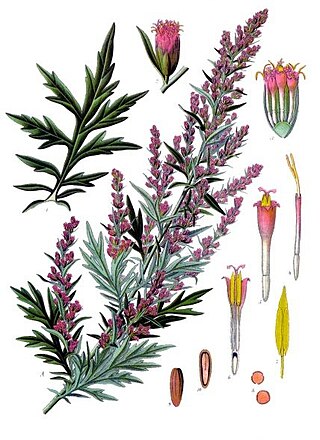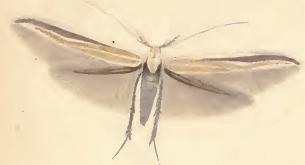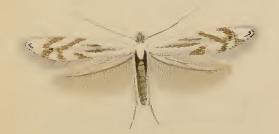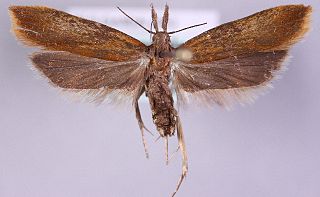
Beta vulgaris (beet) is a species of flowering plant in the subfamily Betoideae of the family Amaranthaceae. Economically, it is the most important crop of the large order Caryophyllales. It has several cultivar groups: the sugar beet, of greatest importance to produce table sugar; the root vegetable known as the beetroot or garden beet; the leaf vegetable known as chard or spinach beet or silverbeet; and mangelwurzel, which is a fodder crop. Three subspecies are typically recognised. All cultivars fall into the subspecies Beta vulgaris subsp. vulgaris. The wild ancestor of the cultivated beets is the sea beet.

Artemisia is a large, diverse genus of plants with between 200 and 400 species belonging to the daisy family Asteraceae. Common names for various species in the genus include mugwort, wormwood, and sagebrush.

Artemisia vulgaris, the common mugwort, is a species of flowering plant in the daisy family Asteraceae. It is one of several species in the genus Artemisia commonly known as mugwort, although Artemisia vulgaris is the species most often called mugwort. It is also occasionally known as riverside wormwood, felon herb, chrysanthemum weed, wild wormwood, old Uncle Henry, sailor's tobacco, naughty man, old man, or St. John's plant. Mugworts have been used medicinally and as culinary herbs.

Barbarea vulgaris, also called wintercress, or alternatively herb barbara, rocketcress, yellow rocketcress, winter rocket, yellow rocket, and wound rocket, is a biennial herb of the genus Barbarea, belonging to the family Brassicaceae.

Mugwort is a common name for several species of aromatic flowering plants in the genus Artemisia. In Europe, mugwort most often refers to the species Artemisia vulgaris, or common mugwort. In East Asia the species Artemisia argyi is often called "Chinese mugwort" in the context of traditional Chinese medicine, or àicǎo (艾草) in Mandarin. Artemisia princeps is a mugwort known in Korea as ssuk (쑥) and in Japan as yomogi (ヨモギ). While other species are sometimes referred to by more specific common names, they may be called simply "mugwort" in many contexts.

Bambusa vulgaris, common bamboo, is an open-clump type bamboo species. It is native to Indochina and to the province of Yunnan in southern China, but it has been widely cultivated in many other places and has become naturalized in several regions. Among bamboo species, it is one of the largest and most easily recognized.

Prunella vulgaris, the common self-heal, heal-all, woundwort, heart-of-the-earth, carpenter's herb, brownwort or blue curls, is a herbaceous plant in the mint family Lamiaceae.

Dichomeris is a genus of moths in the family Gelechiidae erected by Jacob Hübner in 1818.

Artemisia verlotiorum, the Chinese mugwort, is a species of plant in the sunflower family, widespread across much of Eurasia.

Loxostege sticticalis is a species of moth of the family Crambidae. It was first described by Carl Linnaeus in 1761 and is found in the Palearctic and Nearctic realms.

Schinia scutosa, the spotted clover, is a moth of the family Noctuidae. It is found from Europe to southern Siberia, the Near East and the Middle East and from central Asia to Japan. In North Africa it is found from Morocco to Egypt.

Hellinsia lienigianus is a moth of the family Pterophoridae which inhabits coastal areas, dry pastures and waste ground and is found in Africa, Asia, Australia and Europe. Also known as the mugwort plume it was first described by Philipp Christoph Zeller in 1852.

Coleophora ditella is a moth of the family Coleophoridae. It is found from Germany to the Iberian Peninsula, Italy and Bulgaria.

Bucculatrix ratisbonensis is a moth of the family Bucculatricidae. It is found from Fennoscandia to Italy and from Germany to Russia. It was described in 1861 by Henry Tibbats Stainton.

Dichomeris ustalella is a moth in the family Gelechiidae. It is found in south-eastern Siberia, the Caucasus, Transcaucasia, Korea, Japan, China and Europe, where it has been recorded from most of the continent, except for Ireland, the Iberian Peninsula and Scandinavia.
Dichomeris tostella is a moth in the family Gelechiidae. It was described by Stringer in 1930. It is found in Japan, Korea, and the Russian Far East.
Dichomeris leptosaris is a moth in the family Gelechiidae. It was described by Edward Meyrick in 1932. It is found on the Japanese islands of Hokkaido and Honshu.

Phytoecia nigricornis is a species of beetle in the family Cerambycidae. It was described by Johan Christian Fabricius in 1781, originally under the genus Saperda. It has a wide distribution throughout Europe. It measures between 8 to 13 mm. It feeds on Glebionis segetum, Solidago virgaurea, Artemisia campestris, Artemisia absinthium, Artemisia vulgaris, Artemisia sieversiana, Leucanthemum vulgare, and Tanacetum vulgare.

Phytoecia rufiventris is a species of beetle in the family Cerambycidae. It was described by Gautier des Cottes in 1870. It is known from Russia, Japan, Taiwan, Mongolia, North Korea, South Korea, China, and Vietnam. It feeds on Artemisia vulgaris.















